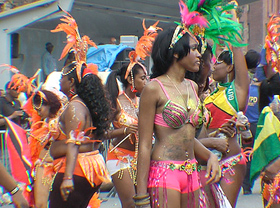Labour Day Countdown

In pockets of central Brooklyn this month, rolls of galvanised wire are being twisted and bent into compliance.
Steel drums are getting hammered. And beads, millions of beads are being hand-stitched and hot-glued onto panties and bras in dark, tiny basements.
It’s Carnival time in the big city.
On Labor Day (3 September), millions of people from far and wide will converge on Eastern Parkway in Brooklyn for the annual West Indian American Day parade.
Rising costs
At the mas camp of the fastest-growing band in New York, leaders of Ramajay Mas (masqueraders) are ordering beads by the thousands and stressing over the rising cost of feathers.
At $28 a yard, it’s particularly upsetting, since the band is playing “Wings”.
Theirs is a family affair, an all-inclusive band started four years ago by three Maynard sisters and three friends with a helping hand from mom and dad, veterans at mas making.
“We doubled in size since the first year we came out,” said Ramajay President, Reisha Maynard-Holder.
Bad publicity
“Last year was 1,200. We try to keep it to a manageable size. People complain when there’s too much. We get tag-alongs on Eastern Parkway.”
But as they worked on truck licences, catering, and planning a better experience for their masqueraders, Ms Maynard-Holder was anxious about how the parade will bounce back after last year’s bad publicity.
Her dad, Percival Maynard, agreed. He said people were turned off, leading to a drop in registration.
“I think it is having an effect on this year already,” he said. “It’s slow with all the bands.”
It’s a concern shared by the parade’s organisers, the West Indian American Day Carnival Association.
They say planning and preparations are on track, but sponsorship is not.
“Sponsors pulled out. It caused damage to the organisation,” said Deborah Benjamin, vice-president of WIADCA.
“The parade has been safe, regardless of what people have been saying.”
Violent image
By people, she means the New York City press. And in case you missed it, they basically portrayed the festival as an annual orgy of violence.
It all started four hours after the 2011 parade, with the police involved in a shooting in Crown Heights, blocks from the parade route.
Officers were around the corner when one man shot another after an argument.
The police responded with a barrage of bullets, killing the shooter and an innocent woman who happened to be outside sitting on her stoop.
The press linked the killings to the parade.
About a week later, the city press was again outraged, this time by videos on YouTube showing NYPD officers dancing during the parade with costumed masqueraders.
But the biggest blow came in December, when the New York Times reported that police officers on a Facebook group referred to the parade as violent and to West Indians as “savages” and “animals”, posting that, at the next parade, someone should “drop a bomb and wipe them all out”.
Crime-free for years
Ms Benjamin said the comments, though damaging, came from a small group of racist police officers.
“We have been crime free for years,” she said. “All our shows behind the Brooklyn Museum, and the actual parade have been crime-free for a long time.”
She said WIADCA’s committees had been working since April to plan this year’s Labor Day event, meeting police and sanitation officials, as well as organising mas and steel band competitions, Brassfest and kiddies’ carnival.
Still a 'big deal'
Ms Benjamin said that, in spite of everything that had been said, revellers could look forward to the beautiful costumes and great music of the islands on Labor Day.
“We like the fact that so many people could be in one place having a good time, just partying with no problems,” she said. “And that’s a big deal.
“We need sponsors to come back and we need more and better sponsors. But we’re not going to let it die.
“Regardless of what we have to do, we’re not going to let it [the parade] die.”
Back at Ramajay Mas, the Maynards are brainstorming other ways to reinvigorate masqueraders and bring in more participants.
“People are saying they’d rather spend money to play in Miami or Trinidad,” Ms Maynard-Holder said, “because the Parkway is so short and there is no place for us to go at the end.
"We start playing mas at 11:00 and by 4:30, we’re back home. We need the parade route to be longer.”
Tweet
